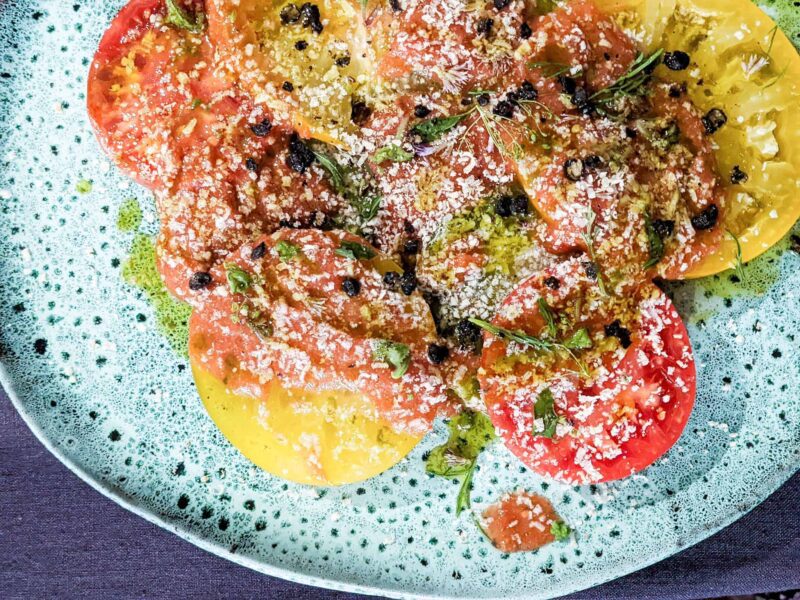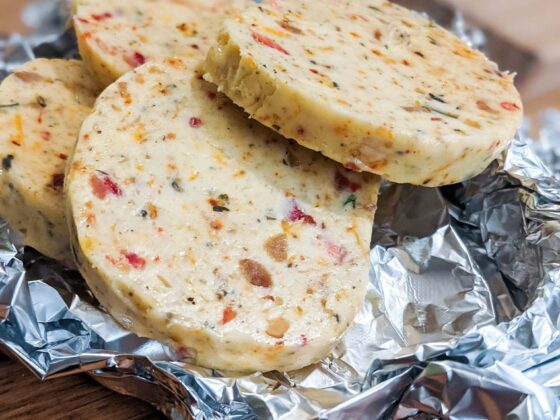The mighty tomato, a fruit (I know, the age-old debate) so wonderful and yet so difficult to find in its absolute glory. Let’s be honest – good tomatoes are hard to find…
The tomato defined a large part of my childhood, from my dad’s delicious tomato and onion salad (which accompanied his multitude of remarkable grilled meats), to strolls through the Bucharest markets with my grandpa. He was the ultimate perfectionist, even more so when he went food shopping. He walked from stall to stall, carefully touching tomatoes (enough to get a feel for their texture without bruising them), lifting them up to his nose for his ultimate test. Both smell and texture had to be perfect, or else he walked away until he found the perfect tomato.
Tomato season is a highlight for me and every year I create new dishes that puts the fruit centre stage.
🔪 Ingredients you’ll need
One or more ripe, beautiful, healthy, juicy heirloom tomato(es)
🍅 200g lacto fermented tomatoes
🌲 2 tsp spruce tip syrup
🧄 1 small garlic clove
🏺 1 tbsp olive oil
🧀 Belper Knolle (or any other type of dry, low fat, crumbly cheese)
⚫️ 1 tbsp fermented black pepper (although black pepper works as well)
🌿 1 small handful of garden herbs and flowers
🧑🍳 How to make the recipe
In a blender, mix the fermented tomatoes, garlic clove, spruce tip syrup and olive oil into a salsa. You can pass that through a muslin cloth if you wish for it to be clearer.
Slice the heirloom tomatoes thinly and spread them onto a plate. Top them with the salsa.
Grate some belper knolle (or cheese of your choice), sprinkle the black pepper on top and finish with the garden herbs and flowers.
👩🔬 How to lacto ferment tomatoes
The vacuum method: Take a couple of ripe tomatoes (using tomatoes that are about to go bad is great for ferments too), slice them thickly, then place them in a vacuum bag with 3-4% salt (so for 100g of tomatoes, 3-4g of salt). You can add herbs or flowers to change the aroma. During elderflower season, there’s nothing I love more than fermenting tomatoes with elderflowers! Leave them outside in a warm place until the vacuum bag has expanded. Open and store in the fridge.
The brine-in-a-jar method: You may choose to use cherry tomatoes or the like, since they will hold their shape much better than sliced tomatoes. Score them with an X at the bottom, then place them in a jar with water. Add 3-4% salt and stir to dissolve the salt. Add some weights at the top of the jar to keep the tomatoes submerged. Keep the jar outside in a warm spot for a couple of days, until the water starts getting fizzy and lightly cloudy.
The speed of fermentation vastly depends on the amount of sugar of the ingredients you are fermenting and the temperature of the environment you are doing it in. The warmer it is, the faster it will be.
The introduction to fermentation no one asked for…
I will take it that you already know what lacto-fermentation is and what it involves. In short, it is a preservation method in which vegetables or fruits are fermented either in a brine or in vacuum. Bacteria breaks down the sugars of the fruits and vegetables and turns it into lactic acid – the lovely flavour that makes us love sauerkraut, kimchi, yogurt and more. Salt is used to to keep the environment healthier, supporting some of the good bacteria and killing some of the bacteria that would otherwise spoil the food. There are a lot of resources out there, but my fermentation bible is Noma’s Guide to Fermentation – with a higher amount of salt for the process, since it makes it safer to ferment in uncontrolled environments, like a home, rather than a fermentation lab.
💡 Here are my rules of thumb when it comes to fermentation:
- 3-4% salt is the ideal amount to keep things lasting longer.
- I like to vacuum ferment more than brines in a jar – mostly because the environment is easier to control
- If there is a while layer forming on top of ferments, that is not mould, nor is it something to worry about – it’s called ‘Kham yeast’ and it is a biofilm created by microorganisms. Spoon it out and all is well, then store ferments in the fridge to avoid more of that white film at the top. Read more about troubleshooting your ferments [here].



